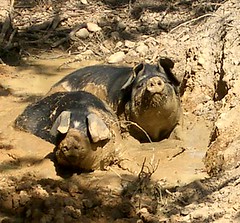












 1
1








John Meshna (owner)
Blue River LLC
1195 Dog Team Road
New Haven, Vt 05472




paul wheaton wrote:
I think it would be good to throw a bunch of food on the ground around the pond in different places for the pigs over a period of six months or so.








Principal - Terra Phoenix Design
http://TerraPhoenixDesign.com








 steve
steve







Brenda
Bloom where you are planted.
http://restfultrailsfoodforestgarden.blogspot.com/
 1
1







 1
1




 1
1




 1
1




 1
1









[img]http://i109.photobucket.com/albums/n52/havlik1/permie%20pics2/permiepotrait3pdd.jpg[/img]
"One cannot help an involuntary process. The point is not to disturb it. - Dr. Michel Odent









My parents dug a pond, it leaked from the start, we tried several things when I still lived at home, but none worked. After I left home, they ran pigs in it, just fenced it in with electric fence. The pigs when in there a couple of years, the pond started holding the next spring, and has held to this day. Pigs have been gone four years now.
It is pretty common practice around here if a pond will not hold. I don't know if it not working.
Quite a few years ago we built a pond that did not seal. We fenced it in and ran hogs for three years at the suggestion of my Uncle. The third year one of the piglets drowned in the pond. We moved the hogs. That pond is still holding water. I know of several other ponds done the same way. As seagullplayer says, pretty common practice around here.








Brenda
Bloom where you are planted.
http://restfultrailsfoodforestgarden.blogspot.com/








The ultimate goal of farming is not the growing of crops, but the cultivation and perfection of human beings. - Masanobu Fukuoka
 1
1








"the qualities of these bacteria, like the heat of the sun, electricity, or the qualities of metals, are part of the storehouse of knowledge of all men. They are manifestations of the laws of nature, free to all men and reserved exclusively to none." SCOTUS, Funk Bros. Seed Co. v. Kale Inoculant Co.








paul wheaton wrote:
I've seen this method spelled as "glie" - maybe that will help the googlers.
I heard that it was a popular russian technique. Usually filling a pond bowl with cow manure or hay. Sometimes several feet deep, then channeling in such a large volume of water that the organic matter must stay submerged (I would guess this would be through fall, winter and spring).








paul wheaton wrote:
.... as for squealing, wiggling pigs ... pigs respect a single wire of electric fence .... a lot ...
http://www.greenshireecofarms.com
Zone 5a in Central Ontario, Canada




Life that has a meaning wouldn't ask for its meaning. - Theodor W. Adorno




dirtworks wrote:
I've always found it really hard to get a sqeeling, wiggling pig into a small hole and harder still to make one stay there once inserted.
Pond liners as simple as plastic sheeting or more expensive rubber liners work better. A good layer of clay might work too.




















Every where you came and left you came in the name of love and left a wake of happiness and tenderness and sweet conflict - sweet conflict.
You don't come round......whispering, everywhere, everywhere....calling, I'm calling your number, calling, calling your number, calling, calling, you're everywhere to me.




Fill the bottom of the dried out pond with leaves. They form into a lamentation then break down into a sludgy humus, for lack of a better description. Cheap, easy.
Homesteading and adventure ideas for smart people.
Check out my website at http://GoRambling.com








Benjamin Burchall wrote:So am I understanding correctly that Holzer's pond sealing method is basically to compact the soil that will serve as the bottom of the pond. If that's correct, I imagine a low tech no-pig way to do this would be to take a sledgehammer to the soil. Perhaps lay a small metal plate on the soil and hammer away on top of it? I could see this working on clay soils well.
I've seen work crews working with soil compactors to prepare the ground for building a road or sidewalk before. They look like jackhammers with a metal plate instead of a spike. I suppose you could rent one, right?

|
Always respect your superiors. If you have any. - Mark Twain / tiny ad
Rocket Mass Heater Resources Wiki
https://permies.com/w/rmh-resources
|
.jpg)



